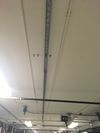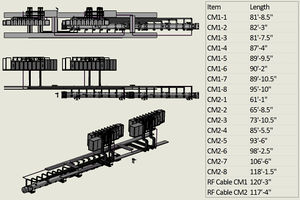Oct 11 2017 WG
Jump to navigation
Jump to search
DRAFT
Waveguide Review notes
There was a review on Oct. 11, 2017 of the design for the waveguide needed for the LERF conversion to LCLS-II cryomodule testing and commissioning.
Presenter: Joe Gubeli
Attending: Kevin Jordan, Steve Suhring, Dave Gelhar, Rick Nelson, Curt Hovater, Ed Daly, Dave Seidman, Tim Davis, Paul Collins, Neil Wilson, Anthony DiPetti, Todd Kujawa
There was a discussion covering topics from re-use of existing waveguide to will the lighting be blocked, here is a summary:
- Should all new components be purchased? Decision was to reuse ~1/2 of existing waveguide parts and purchase all new flex sections since these are the only part prone to leaking. Discussion continued to say that the restoration will be more difficult to re-connect to new cryomodules in the "restoration" phase on the project is complete. A purchase requisition (#373167) [1]has been generated and submitted based on this discussion.
- The new installation of waveguide needs to be pressurized. This will be done by by drilling and tapping (1/8" NPT) the flange near the circulator in the gallery above each SSA. This interlock ties into the PSS and is under their control. They will decide how to route the gas lines and where to locate and secure the pressure switches.
- The longest piece is 20', and weighs ~60 pounds. This will require a two person lift. A detailed work plan must be developed that descibes the sequence of installation and what material handling devices should be used to enhance the ergonomics of the task.
- Work platforms need to be used so that the bolting the waveguide together is chest to head height. These work platforms would be between 24" to 32" high. One option is the used rolling scaffolding, [2] we will work together with EHS&Q (George Perry) to arrive at a satisfactory solution.
- There is a desire by Curt to minimize the RF cable lengths. SLAC routes these cable out the bottom of the LLRF control racks. There are two 36" wide racks, each controlling 4 SSAs and are located on either side of the 8 SSAs. It was decided to route the cables out the bottom of the racks, along the back of the SSA cabinets (there is a 4" gap between the bottom of the SSA rear door and the floor), then cross over the floor (there is 32" between the racks/penetrations & the SSAs) and go down the penetrations to the tunnel. A work platform will be positioned over the cables [3]
- Lightweight power wrenches [4] will be used to secure the bolts, there are ~1600 bolts upstairs & ~2400 downstairs. We will also purchase nuts with captive washers [5] to aid in the assembly. It was recommended that Smitty be consulted on the work plan.
- There needs to be a support structure to secure the waveguide to the ceiling, there was a question about using the existing tray anchors to support additional waveguide. There are a number of 3/8" anchors in the ceiling, [6] each of these has a 4400 pound "pull-out" rating. The existing cable tray is supported by two anchors, spaced at 12' or a rated maximum load of 733lbs/foot. An estimate of the cables in the tray are 100 to 200 pounds per foot in the area above the 'back leg' of the accelerator. The waveguide weighs ~3 pounds/foot X 16 sets or ~50 pounds per foot, worst case. There is no issue to use existing support structure.
- Additional lighting will be installed above the cryomodules. The new cable try will block too much of the installed lighting.
- The borrowed equipment from SLAC that gets tied into the LCW system needs a pressure systems design authority sign-off
- Fire brick foam will be inserted into the penetrations after the pulls are complete
- The temperature, delta T, pressure, pressure drop, and GPM specification for the SSA & circulator must be confirmed with SLAC.



